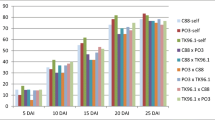Abstract
Solanum tuberosum L. Gp. Tuberosum populations that had been recurrently selected for resistance to potato leafhopper,Empoascafabae (Harris), were tested for levels of foliar solanidine glycosides. Leafhopper infestation level was 57% lower than for the unselected population after seven generations of selection. The mean concentrations of foliar solanidine glycosides significantly (P<05) increased from 40 mg/100 g fresh weight (fw) in the unselected population to 65 mg/100 g fw in the population developed from seven generations of selection for leafhopper resistance. The linear relationship between the level of leafhopper infestation and the concentration of foliar solanidine glycosides among population means was significant (P<01) and negative (r=−0.85).
Compendio
Poblaciones deSolanum tuberosum L. Gp. Tuberosum que habían sido repetidamente seleccionadas paira resistencia a la cigarrita de la papa,Empoascafabae (Harris), fueron probadas para niveles foliaires de glicósidos de solanidina. Después de siete generaciones de selección el nivel de infestación de la cigarrita fue 57% más bajo que para las poblaciones no seleccionadas. Las concentraciones medias de glicósidos de solanidina incrementaron significativamente (P<,05), de 40 mg/100 g de peso fresco (pf) en las poblaciones no seleccionadas, a 65 mg /100 g de pf en la población desarrollada en las siete generaciones de selección para resistencia a la cigarrita. La relación lineal entre el nivel de infestación de la cigarrita y la concentración foliar de glicósidos de solanidina entre las medias de las poblaciones fue significativa (P<,01) y negativa (r=−0,85).
Similar content being viewed by others
Literature Cited
Dahlman, D.L. and E.T. Hibbs. 1967. Responses ofEmpoasca fabae (Cicadellidae: Homoptera) to tomatine, solanine, leptine I; Tomatidine, solanidine, and demissidine. Ann Entomol Soc Am 60:732–740.
Gregory, P., S.L. Sinden, S.F. Osman, W.M. Tingey and D.A. Chessin. 1981. Glycoalkaloids of wild, tuber-bearingSolanum species. J Agrie Food Chem 29:1212–1215.
Healy, M J.R. and H.R. Taylor. 1962. Tables for power-law transformations. Biometrika 49:557–559.
Horsfall, J.G. and R.W. Barratt. 1945. An improved grading system for measuring plant diseases. Phytopathology 35:655.
Osman, S.F., S.F. Herb, T.J. Fitzpatrick and P. Schmiediche. 1978. Glycoalkaloid com- position of wild and cultivated tuber-bearingSolanum species of potential value in potato breeding programs. J Agrie Food Chem 26:1246–1248.
Raman, K.V., W.M. Tingey and P. Gregory. 1979. Potato glycoalkaloids: Effect on survival and feeding behavior of the potato leafhopper. J Econ Entomol 72:337–341.
Sanford, L.L. 1979. Effect of random mating on yield and specific gravity in twoSolanum tuberosum subsp.tuberosum populations. Am Potato J 56:597–607.
Sanford, L.L. and T.L. Ladd. 1983. Selection of resistance to potato leafhopper in potatoes. III. Comparison of two selection procedures. Am Potato J 60:653–659.
Sanford, L.L. and T.L. Ladd, Jr. 1987. Recurrent selection for potato leafhopper resistance in potato,Solanum tuberosum L. Gp. Tuberosum. Am Potato J 64:367–375.
SAS/STAT Guide, Version 6. 1987. SAS Institute Inc., Cary, N.C.
Sinden, S.L. and L.L. Sanford. 1981. Origin and inheritance of solamarine glycoalkaloids in commercial potato cultivars. Am Potato J 58:305–325.
Tingey, W.M., J.D. Mackenzie and P. Gregory. 1978. Total foliar glycoalkaloids and resistance of wild potato species toEmpoascafabae (Harris). Am Potato J 55:577–585.
Van Gelder, W.M.J., J.H. Vinke and J.J.C. Scheffer. 1988. Steroidal glycoalkaloids in tubers and leaves ofSolanum species used in potato breeding. Euphytica S:147–158.
Van de Klashorst, G. and W.M. Tingey. 1979. Effect of seedling age, environmental temperature, and foliar total glycoalkaloids on resistance of fiveSolanum genotypes to the potato leafhopper. Environ Entomol 8:690–693.
Author information
Authors and Affiliations
Rights and permissions
About this article
Cite this article
Sanford, L.L., Deahl, K.L., Sinden, S.L. et al. Foliar solanidine glycoside levels in Solanum tuberosum populations selected for potato leafhopper resistance. American Potato Journal 67, 461–466 (1990). https://doi.org/10.1007/BF03044513
Accepted:
Published:
Issue Date:
DOI: https://doi.org/10.1007/BF03044513




